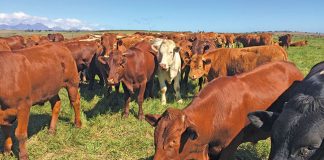
Donkeys are herd animals, like zebra and horses. The herd is usually led by a dominant stallion, or ‘jack’. Each herd may contain between 20 and 30 mares, as well as foals, fillies, colts and young stallions under 18 months of age. Donkey mares, called ‘jennys’ or ‘jennets’, normally start breeding at about two years of age. They are in season for three to 15 days every 21 to 30 days. Pregnancy lasts 11 to 13 months. In general, donkeys breed every second year.
Foals usually wean spontaneously at about 12 months. After 18 months, the young stallions are often driven out by the dominant stallion to form bachelor (all-male) herds. Mature stallions can fight to the death, biting at each other’s throats and kicking viciously. They may also attack young stallions, or even humans.
Select for good temperament
Large herds of semi-wild donkeys on communal grazing are not uncommon, particularly in the more arid areas. Mostly, however, the herds are smaller.Half-wild stallions can cause severe injuries to donkeys in such herds if they are aggressive, and it’s best to castrate all non-breeding stallions at about 18 months of age. Breeding stallions should always be selected for good temperament and preferably put to work at about two years of age. In rural areas, stallions well over 20 years of age sire foals and still earn their living pulling a cart.
Training donkeys: be firm but gentle
In many parts of South Africa, people advertise themselves as donkey trainers. If there are any in your area, visit them to see how good they are. The donkeys in their care should look healthy and be free of wounds and saddle sores. It is reasonably easy to teach a donkey to pull a cart, provided you pair it with a trained donkey to give it confidence.
Generally, training starts at 18 months of age, and a young donkey will be available for work at 24 months, provided it has received good food and weighs at least 150kg. Donkeys do not get stressed if treated firmly, yet quietly. Cruelty has no place in the training of donkeys. A short stick or riding crop can be used to encourage them to move forward, but severe whipping or beating may cause a donkey to kick or refuse to move.
If you use a cattle whip, remember that the cracking of the whip is simply a signal to the donkey. The whip should never be used to beat the animal. It is also illegal in terms of the Animal Protection Act to beat a donkey or overwork it.
When teaching a donkey to move forward, do not drag it, as it will lean backwards away from you. If you hold it together with another donkey and encourage it by clucking or tapping with a riding crop, it will move forward when the trained donkey does so.
Precision through voice commands
A donkey responds well to voice commands and can be taught to move forward, turn left or right and stop, obeying only its owner’s voice. It’s a delight to watch a traditional trainer working with donkeys. These trainers can plough a land with eight donkeys, using only the crack of a whip and their voices to control this large team.













